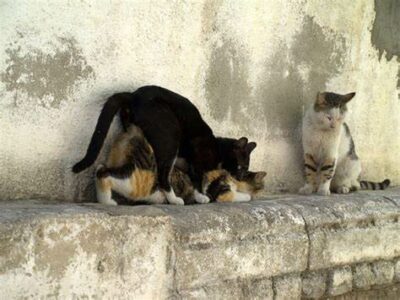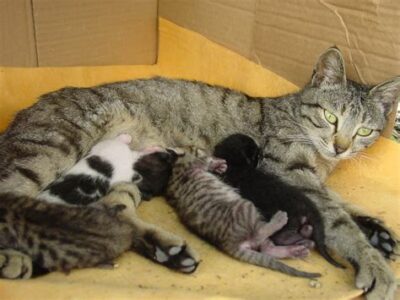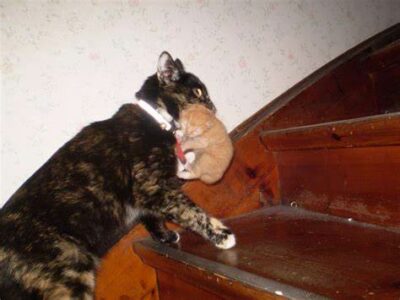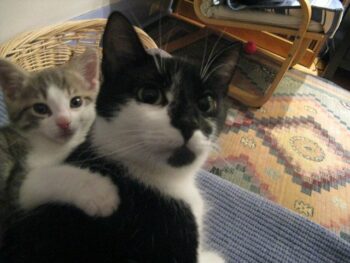If you have a pregnant female cat, you may be wondering what you need to know to help her along with her pregnancy. You may also find it valuable to know how to care for your soon-to-be mother in the best way. What mama cat behavior can you expect?
Her First Heat
Perhaps she seems too young to you. However, kittens have been known to go into heat (estrus) as early as four months of age. The average age for the first heat is six months. If you don’t practice vigilance, she will find a way to escape to her first lover.
If she has not escaped the house and you want to avoid the appearance of kittens, get her to the vet right away and get her spayed. It’s the only way to keep her from going into heat. If you don’t spay her in time, you may learn she is pregnant. Then it’s too late.
After the kittens are born, wait five to six weeks until kittens are close to being weaned. Then get Mama spayed, as she could soon become pregnant again.
Mating And Conception

Did you know that cats do not ovulate until they mate? Thus, kitty first has to find a male partner, usually an easy matter, and once they have mated, kitty will ovulate. This process is moved along by the male cat’s barbed penis, which stimulates the female to ovulate.
Perhaps that might explain why a mother cat can have five kittens, each one with a different father. As they say, variety is the spice of life.
What To Expect Of Your Pregnant Kitty
Okay, she’s pregnant — Now what can you expect? She will begin showing signs of pregnancy around three weeks after mating. Total gestation period normally lasts from 60 to 67 days. During this period, she may show significant changes in behavior. These include:
- Heat cycle ends, which means she stops the head rubbing, genital licking, spraying, and howling.
- Affectionate and loving behavior may increase
- Appetite and hours of sleep may also increase
If your pregnant cat shows symptoms such as sudden appetite or weight loss, severe lethargy, or lack of coordination and depression, you’d better call the vet.
Nesting Behavior
During the first couple of weeks of kitty’s pregnancy, mama cat may show nesting behavior. She will look for an isolated, quiet, dark place for having her kittens. Perhaps you can place a large box with bedding, either dry paper or blankets, in the spot she has selected.
If you set this spot up early on, mama cat can use it while awaiting the arrival of her kittens. Make sure it is large enough to accomodate mama and her babies.

Care And Feeding During Pregnancy
Besides providing a suitable box for nesting, make sure Mama Cat has a comfortable place to sleep. Put a litter box close by, plus a scratching post and toys. Remember that Mama Cat also needs sufficient exercise.
Nutrition is important — you must provide adequate nutrition for the mama and her growing babies. You need to increase the quantity of food as well as the quality. Feed her either kitten food or a diet labeled to meet the needs of gestation and lactation. (pregnancy and nursing)
Behavior Before And During Labor
At about 24 to 48 hours before labor, your cat may lose her appetite or seem anxious or sleepy. Common behavior during the first stages of labor include the following:
- Meowing and panting
- Rearranging the bedding in her nest
- Licking the perineal area or the mammaries
- Many litter box visits
About an hour after the mother cat begins labor, the kittens will begin to appear. The mother, or queen, will forcefully lick each kitten after its birth. This crucial step will help remove the kitten’s fluid-filled amniotic sac, thus allowing the kitten to breathe.
This removal also helps stimulate respiration and circulation. Normally, the mother will also chew off each kitten’s umbilical cord. If the queen does not take care of these two steps, it may become necessary to intervene to help out.

However, it’s better to allow mama to complete as much of the birthing process on her own as possible. Doing so encourages the natural bonding between mother and kitten. So, keep your distance during the birthing process as much as possible to avoid stressing mama.
What To Expect The First Three Weeks After Birth
The queen will give her new family intensive care during the first three weeks of their lives. She may appear more nervous or aggressive than usual during this time. It’s part of her instinct to protect those new babies.
Mama cat may move her babies during this time. It’s a result of her need to keep her kittens safe from prey. The behavior is more common in first-time mother cats.
My mother had a cat who had a male cat-friend. They shared the house, and he was her only companion. When they had kittens, the dad felt the need to help. When Mama Cat moved the kittens, Dad did his share, both of them carrying a kitten to a new nest.

Realize the importance of not handling the kittens as much as possible during their first few weeks of life. Being still young and fragile, they need time to develop and grow stronger. During my youth, when we had many kittens, I recall my mom’s caution against handling the babies too soon.
Postnatal Care For Mama And Babies
Keep the little family in a quiet part of your house. Ideally, a separate room is best. The room should be warm, as getting cold poses a big danger to newborn kittens. For those first weeks, the mother will stay with her babies most of the time, as the kittens tend to nurse around the clock.
Let the mother cat set the pace for your attention to her babies. If you are closely bonded, she may welcome your visits. Nonetheless, refrain from handling the kittens unless Mama Cat initiates it. You could really stress her out if you overstep this boundary.
You might find it a good idea to have some kitten formula on hand and to learn how to feed it, in the event one or more of the kittens is not nursing.
Potential Problems With The Pregnancy
Although most pregnant cats go through gestation with no problems, there are potential difficulties to watch for. Notify your vet if something concerns you. Just as with other animals, the cat may have some fetuses that don’t survive and some that develop birth defects.
Also, a pregnant cat can have complications such as premature labor, metabolic changes, fatty liver, or eclampsia (low calcium). Your vet can help you and kitty through these problems.
Behavior Traits Your Mama Cat May Exhibit
First of all, Mama Cat may be aggressive toward you. Don’t take it personally. Her instincts are simply telling her to protect those kittens from everyone and everything. If she is aggressive toward you, it’s natural and it will pass.

Other behaviors that a new mother cat might exhibit include not having any tolerance for other cats. Even if the cats were previously best friends, she might hiss and growl and even swipe at the other cat, just to make it clear that the babies are off-limits.
It could take a couple of weeks before kitty will let you touch her babies. This behavior may even be helpful, as it is not good for the kittens to be handled much when they are super young.
Mama will communicate with the kittens vocally, calling them back or just letting them know where she is if they wander away. She may also move them to a new location. In the wild, the scent of a new group of kittens might be noticed by a wild animal.
Yes, your home is safe, but Mama still responds to her instincts.
Mama cat’s job becomes teaching and socializing her kittens. Besides grooming them and nudging them around, she may also become the disciplinarian. Thus she teaches them what is acceptable and safe and what isn’t.,
Watch this video for a great laugh. When a kitten gets in a battle with a bedsheet and totally destroys the nicely-made bed, Mama steps in and lets kitten know this behavior is not acceptable. Then she remakes the bed.
What Things Do Kittens Learn From Their Mothers?
Because of the mother-kitten bond, the young ones will learn things faster from their respective mothers than from others. The kitten should remain with their mother until it is at least 12 weeks old. Then they need to be separated after 12 weeks.
The things kittens learn from their mothers are essentials. Mother will teach them how to care for and protect themselves. Because a kitten might feel very comfortable approaching everyone, the mother cat teaches them caution around strangers.
Mother will teach them how to behave around strange dogs or other cats. She will also teach them to run in times of threat.
Hunting — An Important Skill
Though cats receive the hunting instinct at birth, they still need guidance. Mother teaches them hunting basics, such as where to find prey and how to approach and catch them.
One technique she might use: She brings a dead mouse, then eats it to show it’s good food. Next, she lets them play around with a dead mouse and eat it with her.
Then, she might bring a live mouse and teaches them how to kill it with her assistance. Then, they will go on a hunt together until the kittens learn how to hunt for themselves.
Mother also teaches them what is safe to eat and what they should avoid.
Where’s The Bathroom?

Kittens will excrete anywhere. It’s up to Mama to teach them how to handle their excretions and how to use a litter box if one is available. She also teaches them the proper way to bury their waste. Such a tactic helps keep dominant cats and predators away from the kittens.
Communication And Socialization
Mama will teach her babies how to interact and mingle with other young cats. She will also teach them how to share space and to stay out of trouble. She teaches them to hiss and snarl properly, as they may need this knowledge once Mother is gone.
Mama Cat will also instruct kittens how to moderate their behavior when playing so they don’t hurt one another. They must, however, learn to use claws and sharp teeth effectively.
Grooming
Kittens will watch their mother self-clean, and then will try to do the same thing. They first learn how to lick their paws, fur, and ears. Eventually, they become quite adept at self-grooming.
Discipline
As you can see from the video of Mama remaking the bed, discipline can sometimes become necessary. If Baby becomes too aggressive with sharp claws, mother cat will instantly take over and make corrections with deep growls or hissing and assertive meows.
Responding to these discipline traits is understood instinctively by kittens from birth.
Another training technique that is a good one for us to learn when dealing with a cat who needs discipline — Walk away. If the kitten becomes too demanding, or when they make a behavior mistake, if Mother walks away, it’s a clear signal that their demands aren’t working.
This tactic also comes into use at weaning time. If it’s time for the kitten to move on to regular cat food, when Baby tries to nurse, Mama will just get up and walk away.
Mama might also give a light bite or a tap on the head if Baby is seriously misbehaving. The mother cat knows just how much physical pressure to exert on that head tap to get her message across without hurting the kitten.
In Conclusion
As you can see from reading this post, a mother cat travels a long journey from becoming pregnant to raising a family, and in the process has a most important job to do. Her kittens need to learn from her in order to get along in the world.
Mother cats, just like human mothers, perform a vital role in their respective duties. It is up to Mama to teach Baby the most necessary lessons. It’s a heartwarming experience to watch a mother cat raise her young. If you have the chance, learn from and enjoy the experience.
purrfectnpawesome.com/how-do-mother-cats-teach-their-kittens cuteness.com/article/female-cat-behavior http://vetinfo.com/guide-mother-cat-behavior.html kittytrain.com/maternal-aggression-in-new-mother-cats/ thesprucepets.com/cat-mating-and-reproduction-555437

